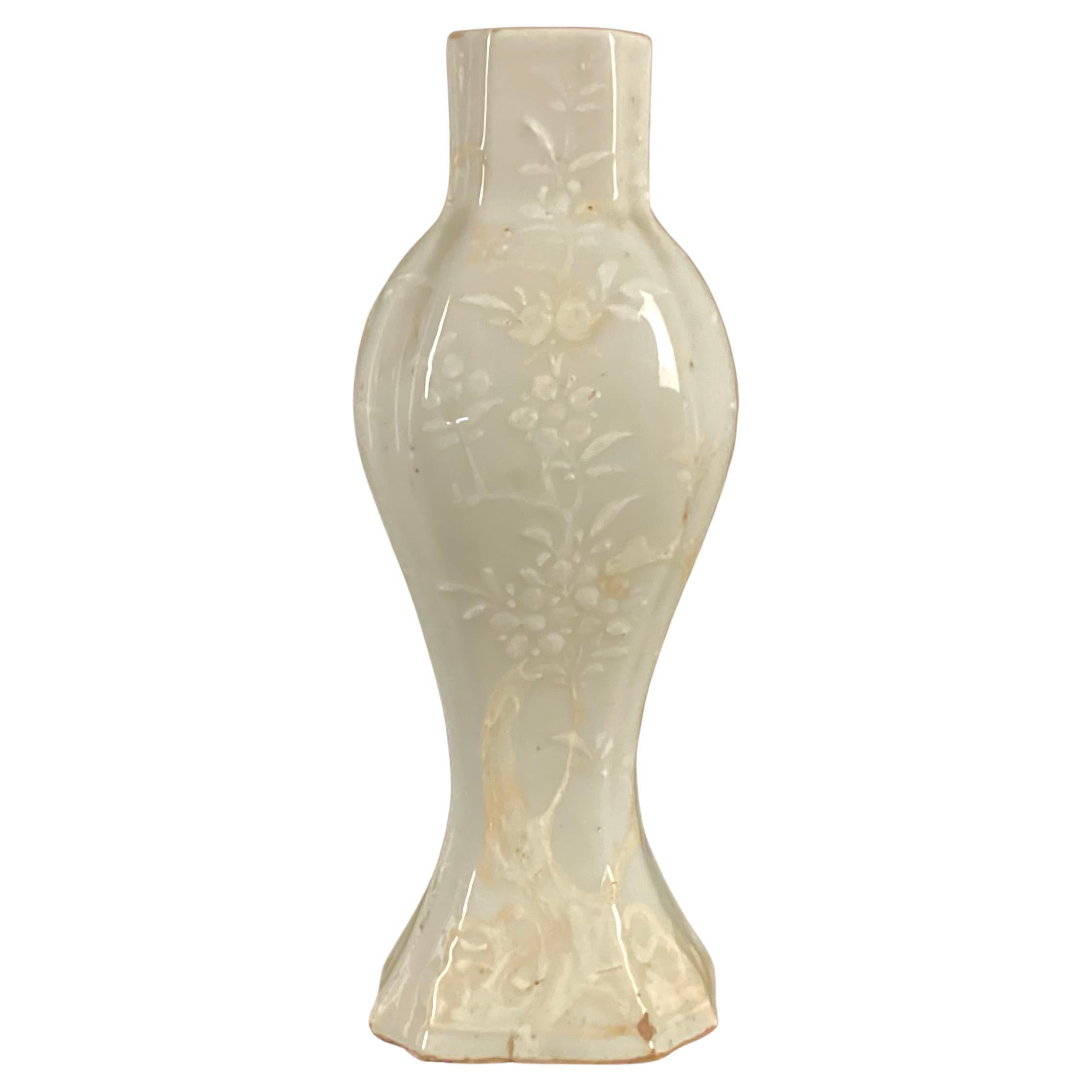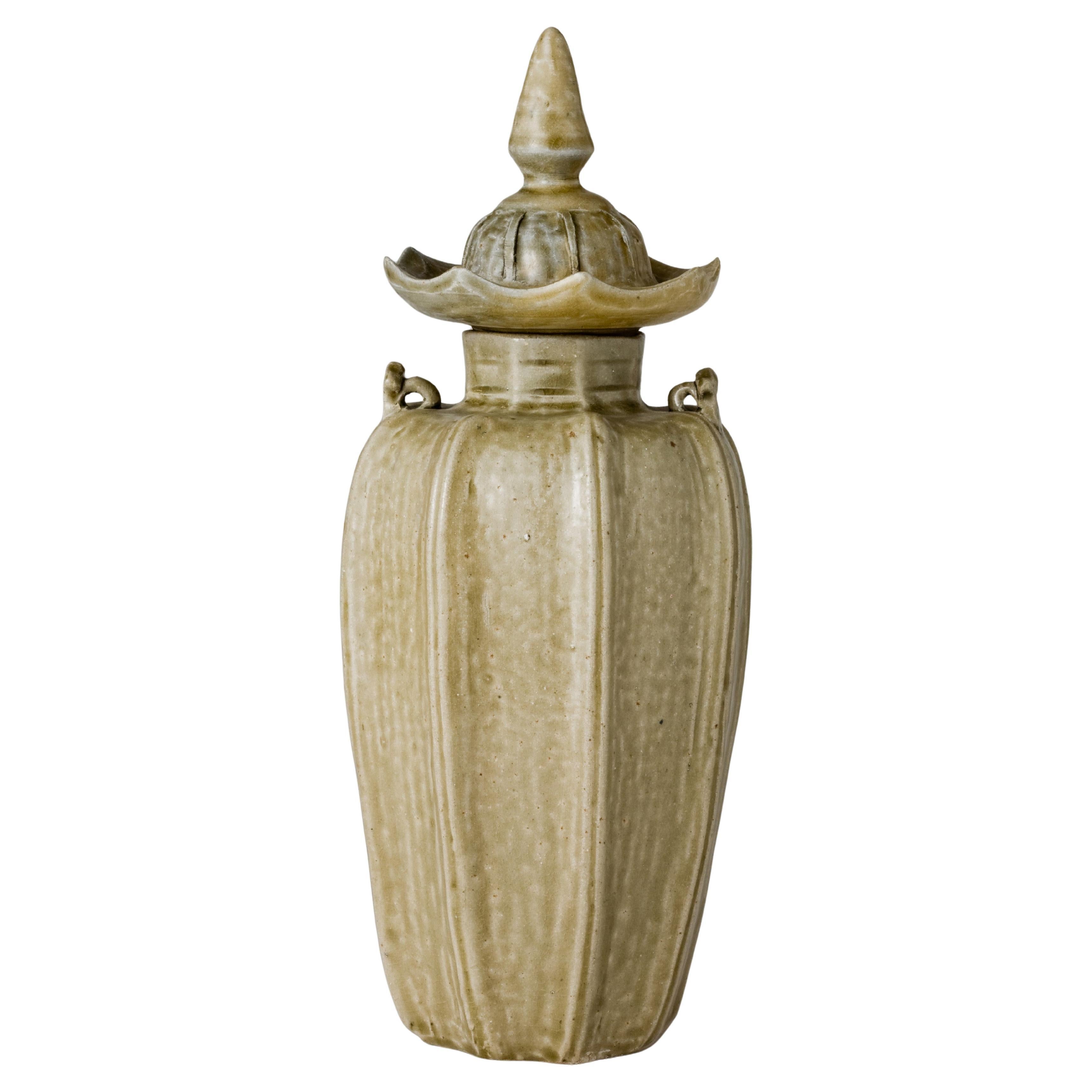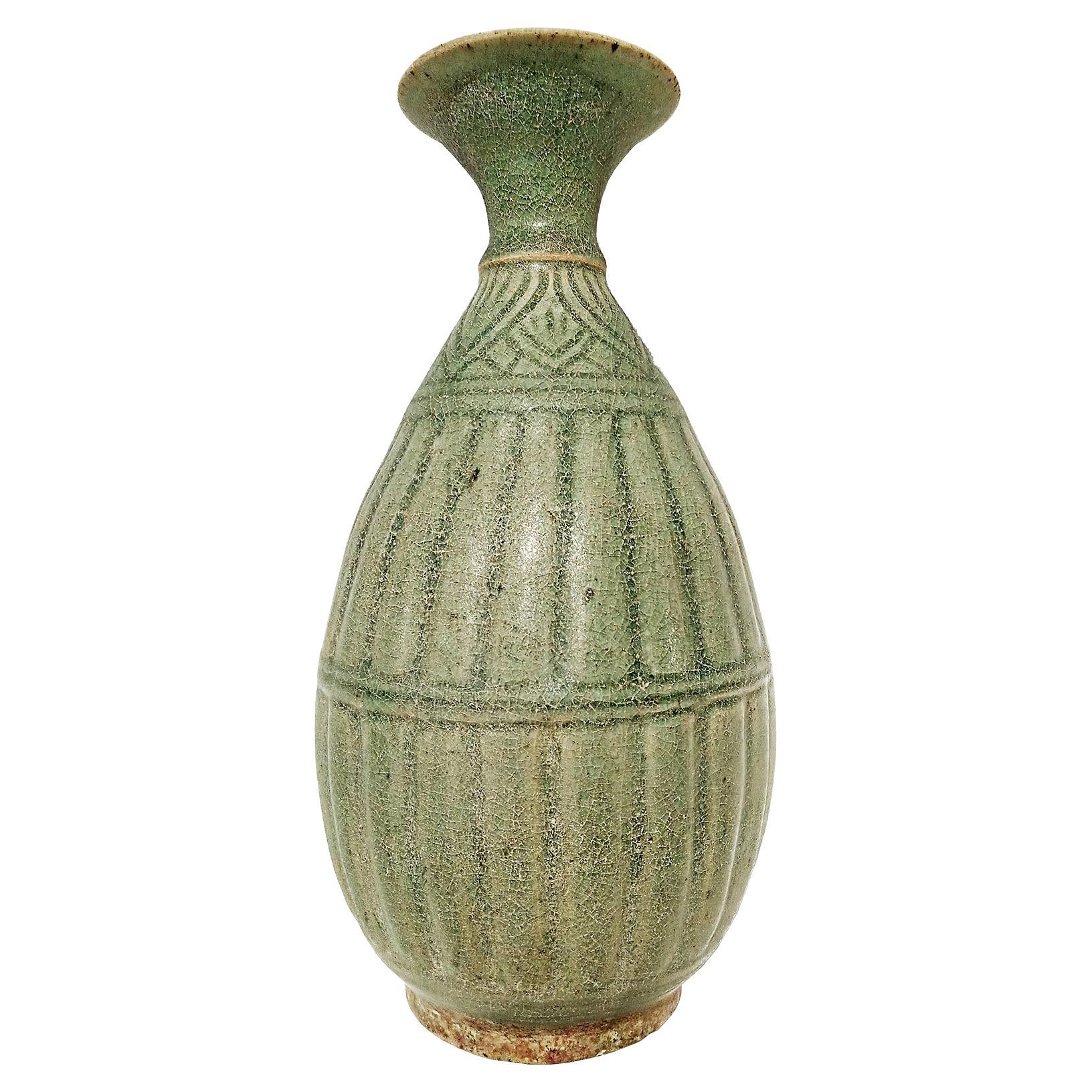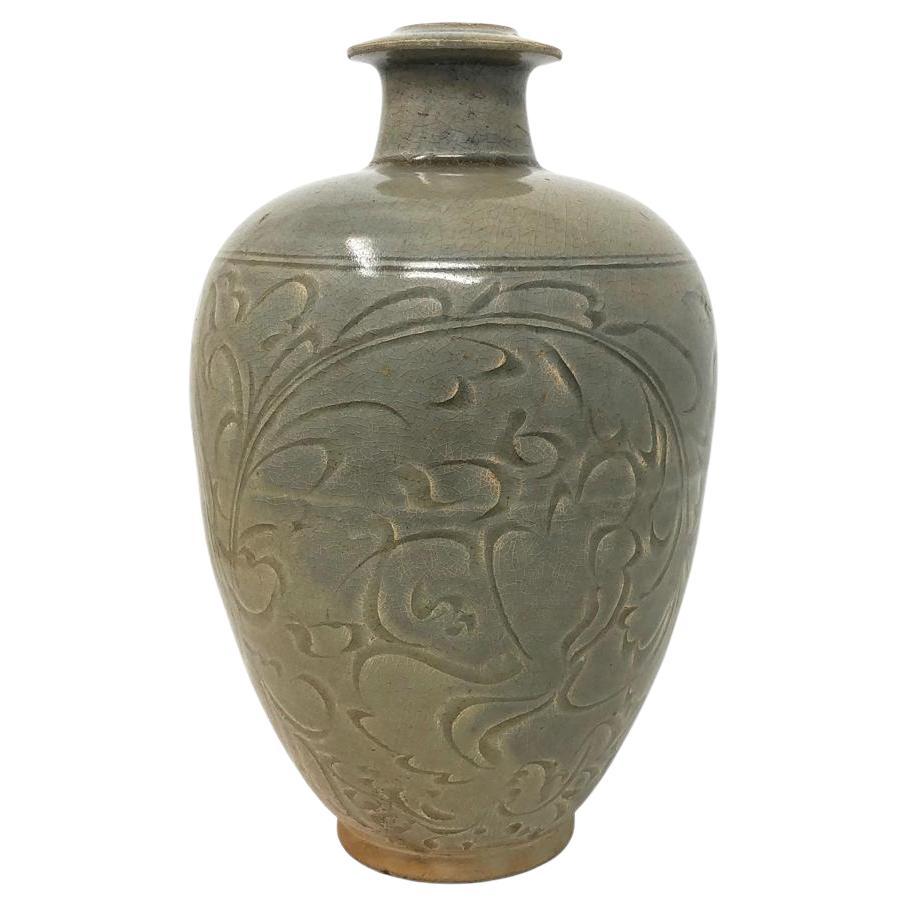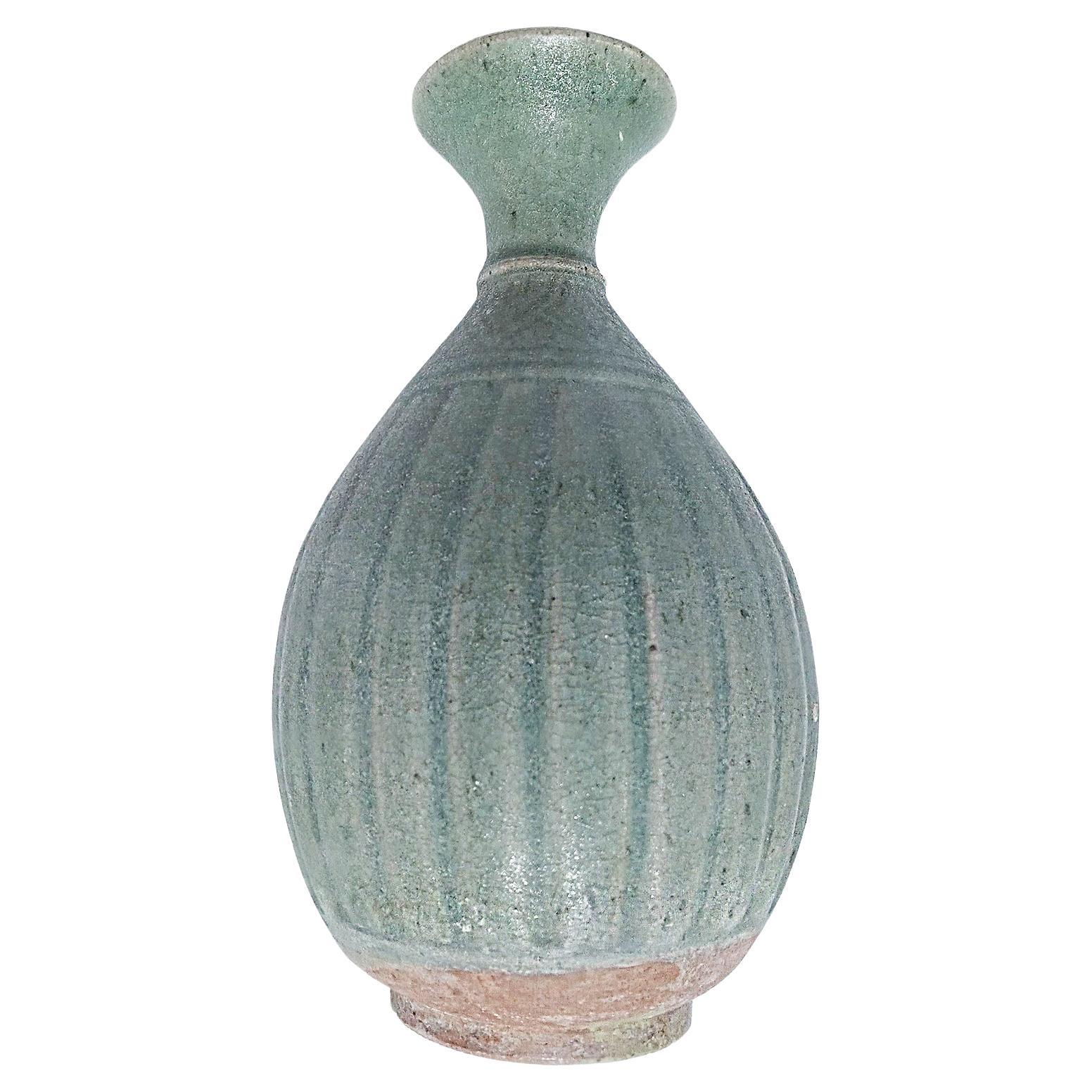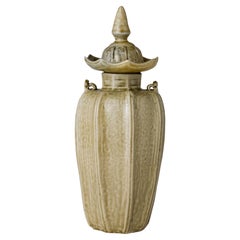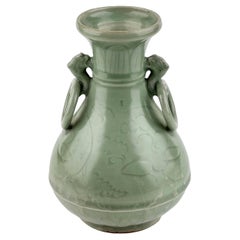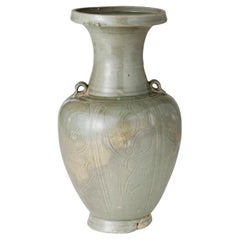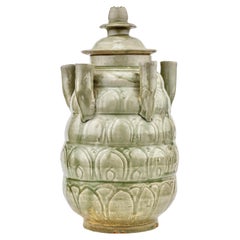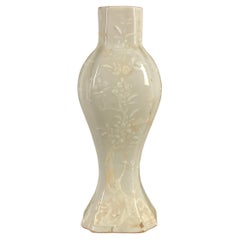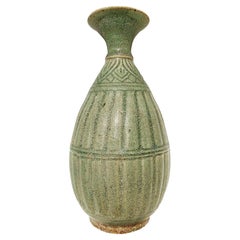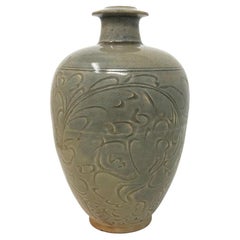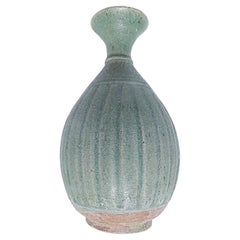Items Similar to A Rare Yue Celadon Cong-Shaped Vase, Western Jin Dynasty(3-5th C)
Want more images or videos?
Request additional images or videos from the seller
1 of 18
A Rare Yue Celadon Cong-Shaped Vase, Western Jin Dynasty(3-5th C)
$7,150
$11,00035% Off
£5,425.26
£8,346.5535% Off
€6,203.29
€9,543.5335% Off
CA$9,986.61
CA$15,364.0235% Off
A$11,103.75
A$17,082.7035% Off
CHF 5,797.77
CHF 8,919.6435% Off
MX$135,159.71
MX$207,938.0235% Off
NOK 73,976.98
NOK 113,810.7435% Off
SEK 69,312.90
SEK 106,635.2335% Off
DKK 46,296.33
DKK 71,225.1235% Off
Shipping
Retrieving quote...The 1stDibs Promise:
Authenticity Guarantee,
Money-Back Guarantee,
24-Hour Cancellation
About the Item
This vase is an exceptionally rare piece and likely the only known example of a Cong-shaped vase from the Jin Dynasty. While some experts may attribute this work to the Song Dynasty or later periods based on its form, it is, in fact, a much earlier creation from the 3rd to 4th century CE during the Jin Dynasty. It was imported from Hong Kong in the late 1990s and was acquired by our gallery as part of a collection that included other Jin Dynasty Yue celadon pieces.
The vase features a cylindrical form with a square (方形) design and geometric incised patterns. While these design elements became more refined and sophisticated during the Song Dynasty (960~1279), their origins trace back much earlier, as evidenced by Cong-shaped jade artifacts dating as far back as 2,500 B.C.E. Examples of these ancient jade Congs can be found in the collections of the British Museum and the Metropolitan Museum of Art (MET). The form of these jade pieces aligns precisely with what is known as Cong-shaped porcelain, establishing them as the true predecessors of later ceramics.
The glaze exhibits a characteristic Yue Ware quality, more muted olive-brown hue. The somewhat rough texture of the surface is also a distinctive trait of early celadon from the Western Jin period.
Period : Jin Dynasty (266 ~ 420 AD)
Type : Cong-Shape Vase
Medium : Yue celadon(Stoneware)
Size : 27.5cm(Height), 11cm(Diameter)
Provenance : The piece was acquired in Hong Kong in the late 1990s.
Condition : Good(Traces of excavation on one side (caused by being laid on that side))
Reference :
1) MET - Ritual object (cong) - Object Number: 2004.52
(Type : related)
2) Christies Hongkong 30 May 2023 - A RARE YUE CELADON CIRCULAR TRIPOD INK STONE AND COVER - Lot 3318
(Price : 189,000 HKD / Type : Related)
3) British Museum - Jade Cong, Liangzhu Culture, 2,500 B.C.E.
(Type : Related)
4) Sotheby's Newyork 18 September 2024 - A 'Yue' celadon-glazed ram-form water vessel, Western Jin dynasty - Lot 232
(Price : 12,000 USD / Type : Related)
* Yue Celadon
Yue celadon, also known as Yue ware, is a type of Chinese pottery with a celadon glaze, originating from the eastern Han dynasty (25~220 AD) in the Zhejiang province. The name 'Yue' comes from the Yue kilns which were among the earliest to develop the celadon technique. Yue ware is known for its jade-like glaze, which can range in color from bluish-green to olive green.
Yue celadon was highly regarded during its time and was the first Chinese ware to be imported in large quantities to the Middle East and Africa, significantly influencing the development of ceramics in those regions. The production of Yue ware continued to evolve, and during the Tang dynasty (618-907 AD), it became more refined with more complex shapes and decorations. By the time of the Song dynasty (960~1279 AD), it had greatly influenced other kiln traditions, leading to the development of the classic longquan celadon, which became one of China’s most famous ceramic products.
Yue celadon traditionally embodies elements of auspiciousness and good fortune in Chinese culture. The jade-like celadon glaze is often associated with longevity and health. Various motifs and shapes inscribed on the pottery frequently symbolize luck and prosperity. For example, lotus patterns may represent purity and immortality, while animal figures like the lion symbolizes power, courage, and strength. Lions are considered protectors that ward off evil spirits and bring forth good luck. Furthermore, Yue celadon wares were commonly used as tomb offerings in ancient China, believed to bring fortune and well-being to the deceased in the afterlife.
- Dimensions:Height: 10.83 in (27.5 cm)Diameter: 4.34 in (11 cm)
- Materials and Techniques:Celadon,Glazed
- Place of Origin:
- Period:
- Date of Manufacture:Jin Dynasty(3-5th Century)
- Condition:Minor fading.
- Seller Location:seoul, KR
- Reference Number:1stDibs: LU9577243777312
About the Seller
4.8
Gold Seller
Premium sellers maintaining a 4.3+ rating and 24-hour response times
Established in 1999
1stDibs seller since 2023
38 sales on 1stDibs
Typical response time: <1 hour
- ShippingRetrieving quote...Shipping from: seoul, Korea South
- Return Policy
Authenticity Guarantee
In the unlikely event there’s an issue with an item’s authenticity, contact us within 1 year for a full refund. DetailsMoney-Back Guarantee
If your item is not as described, is damaged in transit, or does not arrive, contact us within 7 days for a full refund. Details24-Hour Cancellation
You have a 24-hour grace period in which to reconsider your purchase, with no questions asked.Vetted Professional Sellers
Our world-class sellers must adhere to strict standards for service and quality, maintaining the integrity of our listings.Price-Match Guarantee
If you find that a seller listed the same item for a lower price elsewhere, we’ll match it.Trusted Global Delivery
Our best-in-class carrier network provides specialized shipping options worldwide, including custom delivery.More From This Seller
View AllA Rare 'Yue' Celadon Glazed Octagonal Vase, Western Jin Dynasty (266 - 316 AD)
Located in seoul, KR
Finely potted with incurved facetted sides divided by raised ribs and set with two short lugs to the shoulder, the body rising to a short octagonal neck, the domed cover of conforming section, surrounded by an upturned rim and surmounted by a bud finial, applied overall with a celadon glaze of the period.
A related vase of this rare and charming form, in the Zhenjiang Museum, Zhenjiang, is illustrated in the Complete Collection of Chinese Ceramics. Song, vol. 8, Shanghai, 1999, pl. 52. Vases of related octagonal shape were produced at the Ding kilns, in Hebei province, and the qingbai kilns in Jiangxi province; see a Ding vase in the Palace Museum, Beijing, illustrated in Selection of Ding Ware. The Palace Museum’s Collection and Archaeological Excavation, Beijing, 2002, pl. 37; and a qingbai example, from the Meiyintang collection, illustrated in Regina Krahl, Chinese Ceramics from the Meiyintang Collection, vol. 3 (II), London, 2006, pl. 1590; and another carved with a floral scroll, included in the exhibition Song Ceramics from the Kwan Collection, Hong Kong Museum of Art, Hong Kong, 1994, cat. no. 105.
Period : Western Jin Dynasty (266 - 316 AD)
Type : Octagonal Vase
Medium : Yue celadon...
Category
Antique 15th Century and Earlier Hong Kong Han Antiquities
Materials
Celadon
$19,975 Sale Price
75% Off
Carved Longquan Celadon Vase, Yuan-Ming Dynasty
Located in seoul, KR
A graceful baluster form with a flared mouth, a rounded body, and a slightly raised foot. The vase features two intricate handles in the shape of animal figures holding large looped ...
Category
Antique 15th Century and Earlier Hong Kong Ming Antiquities
Materials
Celadon
$4,900 Sale Price
30% Off
Celadon Vase, Five Dynasties or Northern Song dynasty, 10th-11th Century
Located in seoul, KR
The form of Longquan celadon vases from the Northern Song dynasty evolved from an early design with a long neck and tapering body to a later ovoid body with a shorter neck. Over time, the glaze developed a more olive tone, and the carved decorations became more pronounced and intricate. Examples of such vases include one without a cover dated to the Yuanfeng era (1078~1085) and documented in literature, and another similar vase without loop handles preserved by the Qingyuan County Cultural Relics Bureau. An earlier example featuring loop handles and a lotus-like cover is also mentioned in historical texts.
The use of Longquan covered vases, especially as funerary jars for offerings like wine and grains, was highlighted by an inscription on a piece from the Sir Percival David Collection, London. This inscription wishes for the vessel to preserve fragrant wine for centuries, blessing the owner with prosperity, longevity, and a vast lineage, dated to the third year of the Yuanfeng period (1080). This practice was common in the regions of Southern Zhejiang and Northern Fujian. A similar celadon vase from the Linyushanren collection was auctioned at Christie’s Hong Kong, emphasizing the cultural and historical significance of these artifacts.
Period : Five Dynasties or Northern Song Dynasty
Type : Celadon, Zhejiang province
Medium : Celadon
Size : 31.5 cm(Height) x 11.5(Diameter)
Provenance : Acquired in late 1990s from Hongkong
Reference :
1) The British Museum image id - 01613270570
2) Christies New York 23–24 MAR 2023 - Important Chinese Ceramics and Works of Art - Lot 1012
(Price Range : USD 18,000 – USD 25,000 / Type : Related)
3) National Gallery of Victoria - Accession Number - AS5-1973
* Celadon from Five Dynasties (907~960) to the early Northern Song Dynasty (960~1127)
The period from the Five Dynasties (907~960) to the early Northern Song Dynasty (960~1127) marked a significant transitional phase in the development of Chinese celadon ceramics...
Category
Antique 15th Century and Earlier Hong Kong Antiquities
Materials
Celadon
$3,960 Sale Price
60% Off
Longquan Celadon Five-Spouted Jar, Northern Song Dynasty (AD 960~1127)
Located in seoul, KR
Thickly potted with an ovoid body of five horizontal lobes tapering toward the top, carries both aesthetic and practical values. The jar is intricately carved with rows of upright lo...
Category
Antique 15th Century and Earlier Hong Kong Antiquities
Materials
Celadon
$1,885 Sale Price
35% Off
A Rare Longquan Celadon 'Peony' Vase Yuan-Ming Dynasty
Located in seoul, KR
This vase features a traditional vase coated with a clear and rich green celadon glaze. A fine network of crazing covers the surface. The neck is adorned with raised vine motifs, whi...
Category
Antique 15th Century and Earlier East Asian Ming Antiquities
Materials
Celadon
$57,850 Sale Price
35% Off
Carved 'Longquan' Celadon-glazed Funerary vase and cover, Song dynasty
Located in seoul, KR
The vase features a ribbed body, subtly enhancing its graceful contours, and is topped with a uniquely sculpted lid adorned with figurative elements.
Period : Song Dynasty
Type : Ce...
Category
Antique 15th Century and Earlier Hong Kong Antiquities
Materials
Celadon
$3,995 Sale Price
50% Off
You May Also Like
Chinese Celadon Vase
Located in Bradenton, FL
Chinese Celadon Porcelain Vase. Vase features a ceramic glaze of pale green color with a white floral and fauna motif embossed throughout. Vase has slightly elongated neck with wide ...
Category
Antique 18th Century Chinese Chinese Export Vases
Materials
Porcelain
$1,700
Thai Celadon Vase, Late 19th Century
Located in New York, NY
A beautiful Celadon vase from Thailand, late 19th Century.
While the golden age of Thai ceramics ended around the 15-16th Centuries, Thai artisans transmitted the craft through generations, later producing smaller numbers of pieces with different clays and glazing techniques, inspired by the original Celadon masters of Places like Si-Satchanalai or Sawankalokh.
This vase is beautifully preserved, measuring approximately 5 inches in diameter and 9.5 inches high. Its crackled finish and beautiful jade-green color...
Category
Antique 1890s Thai Other Vases
Materials
Celadon
$725 Sale Price
20% Off
Chinese Yaozhou Celadon Ceramic Bottle Vase
Located in Point Richmond, CA
Chinese Yaozhou Celadon Ceramic Bottle Vase, Northern Song, Shaanxi Province. A high fired bottle form with narrowed base, bulbous body, high shoulder,...
Category
Antique 15th Century and Earlier Chinese Other Ceramics
Materials
Ceramic, Celadon
Thai Celadon Vase, Late 19th Century
Located in New York, NY
A beautiful Celadon vase from Thailand, late 19th Century.
While the golden age of Thai ceramics ended around the 15-16th Centuries, Thai artisans transmitted the craft through generations, later producing smaller numbers of pieces with different clays and glazing techniques, inspired by the original Celadon masters of Places like Si-Satchanalai or Sawankalokh.
This vase is beautifully preserved, measuring approximately 5 inches in diameter and 9 inches high. Its crackled finish and beautiful jade-green color is reminiscent of the impeccable craft of ancient Southeast Asia ceramics.
Category
Antique 1890s Thai Other Vases
Materials
Celadon
$725 Sale Price
20% Off
Chinese Longquan Style Celadon Vase
Located in Rio Vista, CA
Large, Chinese Longquan style celadon vase with a stunning lotus leaf pattern underglaze and Greek key detail on the perimeter of t...
Category
20th Century Chinese Ming Ceramics
Materials
Porcelain
$900 Sale Price
25% Off
Thai Celadon Vase, Late 19th Century
Located in New York, NY
A beautiful Celadon vase from Thailand, late 19th Century.
While the golden age of Thai ceramics ended around the 15-16th Centuries, Thai artisans transmitted the craft through generations, later producing smaller numbers of pieces with different clays and glazing techniques, inspired by the original Celadon masters of Places like Si-Satchanalai or Sawankalokh.
This vase is beautifully preserved, measuring approximately 6 inches in diameter and 10 inches high. Its crackled finish and beautiful green color is reminiscent of the impeccable craft of Southeast Asia ceramics.
Category
Antique 1890s Thai Other Vases
Materials
Celadon
$750 Sale Price
20% Off
More Ways To Browse
Song Dynasty
Song Dynasty Furniture
Large Celadon
Song Dynasty Ceramics
Chinese Ceramics Song Dynasty
Rare Antique Asian Vases
Green Asian Vessels
3 Chinese Figures
Antique Celadon Vase
Antique Ink Stone
Jade Vases Antique
Song Dynasty Vase
Ancient Chinese Artifacts
Song Dynasty Porcelain
Late Mayers Pottery
Celadon Green Vase
Pottery Lion
Chinese Jade Vase
